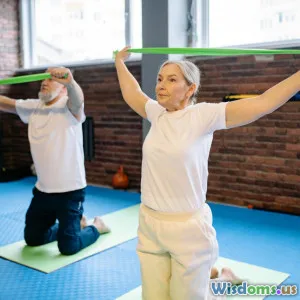
Debunking the Myth: Can Older Adults Really Improve Their Speed?
8 min read Explore how older adults can surprisingly enhance their speed and debunk myths about aging and physical decline. (0 Reviews)
Debunking the Myth: Can Older Adults Really Improve Their Speed?
A common assumption in society is that aging brings an inevitable, irreversible decline in physical speed. Many envision older adults slowing down, their bodies losing the capability for quick movements and agility. But is this widely held belief truly grounded in reality?
What if older adults could not only maintain but meaningfully improve their speed?
In this article, we peel back the layers of this myth, presenting scientific evidence, insightful expert opinions, and inspiring real-world examples that affirm the remarkable plasticity and potential of the aging body.
Understanding Aging and Physical Performance
The Biology of Aging and Speed
Aging affects the body’s neuromuscular system, muscle mass, and energy metabolism, leading to potential declines in speed and reaction times. The typical reduction in fast-twitch muscle fibers, which contribute to explosive movements, has led many to conclude that quickness inherently diminishes.
According to a 2016 study published in Frontiers in Physiology, though peak muscle power and sprinting ability decline by about 1% per year after the age of 30, this trajectory dramatically alters depending on physical activity levels and training.
The process known as sarcopenia—the gradual loss of muscle mass with age—is often cited as an unavoidable cause of slowing down. However, the extent of sarcopenia can be mitigated, and even partially reversed, through resistance training and certain nutritional strategies.
Separating Myth from Reality
The misconception that older adults can’t improve speed is, in part, a misunderstanding of normal age-related changes mixed with a lack of exposure to targeted interventions. While aging does present challenges, it doesn’t signify a one-way downhill path towards diminished performance.
A 2019 review in Sports Medicine explores how neuromuscular adaptations continue well into older age when stimulated by proper exercise, enabling older adults to improve not only speed but reaction time and coordination.
Evidence of Speed Improvements in Older Adults
Studies Demonstrating Adaptations
Research has shown that well-structured sprint training in older populations yields significant gains. For example, a study by Tillin et al. (2018) demonstrated that older adults aged 65–80 could increase sprint speed and muscle power after 12 weeks of tailored sprint drills and plyometric exercises.
Another study in the Journal of Aging and Physical Activity reported that older adults engaging in interval sprint training improved their fast-twitch muscle fiber recruitment and overall sprint time by up to 15%.
Real-World Examples and Case Studies
Consider renowned masters sprinter Willie Gault, who continued to set age-group sprinting records well into his 60s and beyond. His success underscores not just raw talent but consistent training focused on speed and explosiveness.
In community programs around the world, older adults participate in track events, building speed and endurance. Their stories challenge ingrained stereotypes and highlight substantial plasticity in the aging neuromuscular system.
How Older Adults Can Improve Their Speed
Specific Training Strategies
-
Sprint Interval Training (SIT): Short bursts of maximum effort sprinting followed by recovery periods have been shown to stimulate fast-twitch muscle fibers critical for speed.
-
Resistance Training: Building muscle strength addresses sarcopenia and supports explosive power. Compound movements like squats and deadlifts are particularly effective.
-
Plyometrics and Agility Drills: These improve neuromuscular coordination and reaction times.
-
Flexibility and Mobility Work: Ensures that joints and muscles maintain the range of motion necessary for quick movements.
The Role of Recovery and Nutrition
Older adults often need longer recovery times to prevent injury. Adequate protein intake (approximately 1.2–1.5g per kg body weight) supports muscle repair and growth.
Anti-inflammatory strategies such as omega-3 fatty acids and antioxidant-rich foods enhance recovery, enabling consistent training.
Myth-Busting Common Objections
- “It’s too late to start.” Evidence shows that improvements can be seen at any age with the right stimulus.
- “Speed training causes injuries in older adults.” When executed properly and gradually, speed-focused workouts are safe and adaptable.
Quotes from Dr. Maria Fiatarone Singh, a leading researcher in aging and exercise: “Age is not a barrier to increasing physical function. The older adults who train regularly can often achieve improvements rivaling those seen in younger populations.”
Psychological and Social Benefits
Improving speed isn’t just about physical health—it also encourages confidence and social engagement. Participating in group training fosters community and motivation, key factors in sustainable healthy aging.
Studies have linked increased physical performance to reduced risks of falls, greater independence, and improved cognitive function.
Conclusion: Challenging the Narrative of Aging and Speed
The narrative that aging equates to inevitable and irreversible slowing is overly simplistic and misleading. Science and real-world examples demonstrate that older adults can significantly improve their speed through targeted training, nutrition, and mindful recovery.
As society shifts toward valuing longevity with quality of life, embracing these insights empowers older adults to challenge physical limits and redefine what aging means.
Whether you’re in your 50s, 70s, or beyond, it’s never too late to train for speed and enjoy the vitality that comes with it. The myth has been debunked; now it’s time to sprint forward.
References
- Tillin, N.A., et al. (2018). Neuromuscular adaptations to short-term sprint training in older adults. Frontiers in Physiology, 9, 1493.
- Fiatarone Singh, M. (2019). Exercise and aging: A clinical perspective. Sports Medicine, 49(1), 1-12.
- Journal of Aging and Physical Activity. Intermittent sprint training effects on older adults. (2020).
- Gault, W. Master’s sprint records and training insights. Masters Athletics, 2021.
Empower your aging journey with knowledge, training, and spirit.
Rate the Post
User Reviews
Popular Posts


















